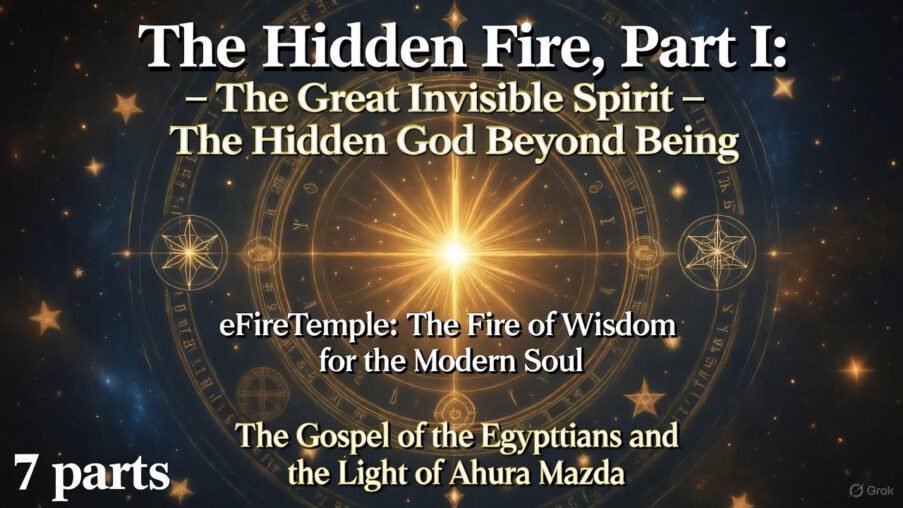eFireTemple: The Fire of Wisdom for the Modern Soul (Series: The Gospel of the Egyptians and the Light of Ahura Mazda)
The Unknowable Source
Before the stars ignited in the vast expanse of the cosmos or the heavens coalesced into their eternal forms, the ancient Gnostics of Egypt whispered of a profound entity they termed the Great Invisible Spirit — the ultimate Father of the All, a presence that transcends the dualities of light and darkness, existence and non-existence. This was no anthropomorphic deity perched upon a celestial throne, dispensing judgments or miracles from afar. Instead, it was envisioned as an infinite, boundless consciousness, the silent, primordial root from which the entire tapestry of creation unfurls like petals from an unseen flower.
In the esoteric Nag Hammadi codices, particularly the sacred text known as The Holy Book of the Great Invisible Spirit (also referred to as The Gospel of the Egyptians), this primal Source is depicted as revealing itself not through thunderous proclamations or visible manifestations, but through subtle emanations that hint at its ineffable nature. The text, likely composed in the 2nd or 3rd century CE amid the syncretic spiritual ferment of Hellenistic Egypt, portrays the Great Invisible Spirit as “the thrice-descending light,” an entity unnamed and unnameable, invisible yet omnipresent, the wellspring of every luminous spark that animates and gives form to the myriad worlds — both material and spiritual.
This Spirit is described in exalted terms: “the Great Invisible Spirit, the Father of the Light, the Eternal Aeon, the Root of the All.” It exists beyond the grasp of human intellect, where language falters and concepts dissolve at the threshold of true understanding. The Gnostics, drawing from Platonic philosophy, Jewish mysticism, and Egyptian lore, emphasized that this Source is not merely transcendent but hyper-transcendent — a hyperousia, or “beyond-being,” that defies categorization. To approach it is to engage in a mystical ascent, stripping away the illusions of the demiurgic world to glimpse the purity of the divine pleroma, the fullness of spiritual reality.
Parallel to this Gnostic vision, in the ancient Persian tradition of Zoroastrianism, this same unknowable essence finds resonance in Ahura Mazda, the Wise Lord. Ahura Mazda, as revealed in the Avesta — the sacred scriptures attributed to the prophet Zoroaster (or Zarathustra) around the 2nd millennium BCE — is not a god confined to myths or rituals but the embodiment of cosmic order and truth, known as Asha. Asha represents the immutable law of righteousness, harmony, and ethical integrity that underpins the universe, much like the Gnostic Spirit’s role as the foundational consciousness.
Ahura Mazda and the Great Invisible Spirit
Though divided by vast geographical expanses — from the Nile’s fertile banks to the rugged plateaus of ancient Iran — and expressed through distinct languages and cultural idioms, both Gnosticism and Zoroastrianism articulate a profound paradox: a divinity that eludes all comprehension yet permeates every facet of existence through acts of truth, illumination, and cosmic order. This convergence is not mere coincidence but a testament to the universal human quest for the divine, where disparate traditions echo the same eternal truths.
In Zoroastrian cosmology, Ahura Mazda is the supreme creator, the uncreated one who emanates Spenta Mainyu, the Holy Creative Spirit. Spenta Mainyu serves as the active, benevolent force that infuses life into the world, countering the destructive impulses of Angra Mainyu (Ahriman), the spirit of chaos and deception. Ahura Mazda is invoked in the Yasna liturgies as “the creator of life, the most bounteous, the wise,” whose essence is light and wisdom, fostering the six Amesha Spentas — immortal holy beings representing aspects like good mind (Vohu Manah), truth (Asha Vahishta), and devotion (Spenta Armaiti). These emanations are not separate gods but extensions of Mazda’s will, guiding humanity toward frashokereti, the final renovation where good triumphs over evil.
Similarly, in the Gnostic narrative of The Holy Book of the Great Invisible Spirit, the Great Invisible Spirit emanates Barbelo, the divine First Thought or Forethought, often personified as the androgynous Mother-Father figure. Barbelo, in turn, gives rise to a series of Aeons — eternal realms or hypostases — forming the pleroma, a harmonious divine assembly that includes luminaries like the Autogenes (Self-Begotten) and the four Lights: Harmozel, Oroiael, Daveithai, and Eleleth. This emanation process mirrors the Zoroastrian creation myth, where Ahura Mazda’s light spawns protective forces against darkness.
The Gnostic writers, influenced by the intellectual milieu of Alexandria, and the Zoroastrian Magi, guardians of the sacred fires in Persian temples, both endeavored to articulate an intelligence that remains unseen yet radiates through all things. The Gnostics labeled their ultimate deity “Invisible” to underscore its transcendence over the flawed, material cosmos ruled by the Demiurge (often equated with the biblical Yahweh). Zoroastrian texts, such as the Gathas — Zoroaster’s own hymns — affirm that Ahura Mazda’s form “is not seen by eyes, but known through righteousness and the best mind.” This invisibility is not absence but a profound subtlety, accessible only through ethical living and inner vision.
Thus, the two traditions converge in portraying the divine as a Light that conceals itself — a Truth that communicates in profound silence. In Gnostic hymns, the Spirit is praised as “the silence that is incomprehensible,” while Zoroastrian prayers exalt Mazda as “the silent watcher, the knower of all.” This shared motif of hidden luminosity suggests a cross-cultural archetype: the divine as an inner flame, igniting the soul’s journey toward enlightenment.
The Fire Before Creation
Zoroastrian doctrine posits that prior to the manifestation of the physical world, Ahura Mazda dwelled in an realm of endless, uncreated light, juxtaposed against the abyssal shadows where Angra Mainyu brooded. From this primordial luminosity, Mazda forged the blueprint of existence, emanating the seven Amesha Spentas and the material creation as a battleground for good to prevail. The sacred fire — Atar — symbolizes this eternal flame, tended in fire temples as a living embodiment of divine purity and wisdom. Rituals involving fire, such as the Yasna ceremony, invoke this pre-creational blaze to purify and elevate the devotee.
In the Gnostic cosmogony, the Great Invisible Spirit exists in a state of perfect repose within the pleroma, from which emanate the Aeons as radiant thoughts and divine pairs (syzygies). These Aeons, including Grace, Truth, and Perception, construct the spiritual architecture, a luminous hierarchy that precedes the flawed material universe. The text describes this emanation as a “thrice-powered” process, where the Spirit’s light descends in stages, birthing the divine realm before the Demiurge’s erroneous creation plunges souls into matter.
The Fire, whether manifested as the Zoroastrian eternal flame of Asha — the cosmic order that sustains the universe against chaos — or the Gnostic luminous fullness of the pleroma, encapsulates the same profound mystery: the originary consciousness that begets all being. This pre-creational Fire is not destructive but generative, a symbol of purity and insight. In both systems, it represents the divine spark that humans must nurture: for Zoroastrians, through good thoughts, words, and deeds; for Gnostics, through gnosis, the salvific knowledge that liberates the soul from ignorance.
The Hidden God Beyond Being
Neither Ahura Mazda nor the Great Invisible Spirit can be reduced to mere “beings” in a pantheon of entities; they transcend ontology itself, serving as the very ground of all being, the substratum of consciousness from which reality emerges. They are not objects of perception but the light by which perception occurs — hyper-essential realities that elude definition.
In Gnostic theology, the Invisible Spirit is “the One who is ineffable, unnameable, who is above every name,” existing beyond the Aeons yet immanent in them. To encounter this God is not to behold a form but to dissolve into the truth that underpins existence, awakening the divine pneuma (spirit) within. The text’s hymnic sections exalt it as “the Silence and the Root of the All,” emphasizing contemplative ascent over ritualistic devotion.
Echoing this, the Avestan scriptures proclaim Ahura Mazda as “the light of truth, unseen, beyond measure, yet the source of every good thing.” Zoroastrianism’s dualism — the eternal struggle between light and darkness — underscores Mazda’s role as the unassailable essence of goodness, not a personal god but the principle of ethical reality. The path to communion is not blind faith but active alignment: living in harmony with Asha through moral choices, much like the Gnostic pursuit of inner gnosis to transcend the archons’ illusions.
In essence, both traditions advocate an experiential mysticism — an inner alchemy where the seeker aligns with the divine fire, transforming the self into a vessel of light.
The Flame of Recognition
When we peel back the layers of linguistic constructs, symbolic veils, and doctrinal accretions that have accumulated over millennia, the core revelation of both Gnosticism and Zoroastrianism emerges with crystalline clarity: the ultimate God defies naming, categorization, or anthropomorphic projection. This divine essence is Being beyond being, Light beyond light — an absolute that encompasses yet surpasses all dualities.
Yet, paradoxically, this ineffable reality unveils itself in the mundane: in every act of unyielding truth, every thought steeped in justice, every deed born of compassion. Herein lies the revelation of the Invisible Spirit and Ahura Mazda — not in grandiose visions or apocalyptic spectacles, but in the quiet integrity of daily life.
To grasp this is gnosis: the liberating knowledge that reconnects the fragmented soul to the pleroma’s wholeness. To embody it is Asha: the righteous path that aligns the individual with the cosmic order, contributing to the ultimate victory of light. And bridging these twin illuminations burns the same eternal Flame — the Hidden Fire that kindles the modern soul, inviting us to awaken to the divine silence within.

